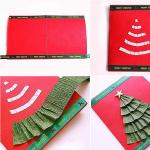How to make a frame for making a blanket. Fluffy gifts from pom poms for the winter holidays
Handmade yarn products always look warm and cozy, you just want to touch them! In this article we will tell you how to make a pom-pom blanket - soft, fluffy and incredibly beautiful.
A blanket for a newborn made of pompons will be a wonderful gift from a loving mother, grandmother or aunt. Having wrapped your baby in such a wonderful blanket when you leave the hospital, you will take wonderful and tender photos in memory of this unforgettable day, and in the future, a blanket of pompons will warm the baby while walking in a stroller or make his sleep at home even sweeter.

We offer you a master class on making a baby blanket from pompons: she gave us a photo for it loving mom twin babies Tatyana Denisova. Those who want to buy such a cute plaid (for their children or as a gift) Tatyana invites to her VKontakte group.
Do-it-yourself pom-pom blanket: a master class with a photo. Instructions for beginners
If you are interested in how to knit a blanket from pompons, we will correct you a little: these products do not fit or sew, but are woven on a special frame. "Knitting" of such a blanket is a long and laborious process, although it does not seem so at first glance after studying MK. Stock up on patience and perseverance, because the result is worth it!
So, let's proceed directly to the master class.
Choosing threads for a plaid from pompons
To make a blanket for a child, choose the softest and most delicate yarn - 100% acrylic is ideal for this purpose. In the absence of allergies, wool and wool can also be used, but pay attention that your threads are not prickly. In our case, we used 100% VITA Baby acrylic yarn (400 m / 100 g): 3 skeins of peach color and 5 skeins of white with colored veins.
Why is it better to use two colors of yarn? This will greatly simplify the manufacture of your blanket: you do not have to count the number of trimmed threads when forming pompons.

Eight skeins of yarn will be enough for you to make a blanket measuring 150x100 cm. If you plan to make a blanket for a newborn, the dimensions will be different - 80x80 cm or 85x85 cm; the consumption of yarn will accordingly be less, 5-6 skeins.
Preparing a frame for making a blanket from pompons
This stage in the process of making a blanket is preparatory, and usually falls on the shoulders of the male half. To weave a blanket, you need a wooden frame or a sheet of plywood, along the perimeter of which, at equal distances (usually 4 cm), you need to drive in nails / screw in screws or self-tapping screws. The size of your frame is the approximate size of the future blanket. However, it makes sense to make the frame a few centimeters wider and longer, since the yarn, removed and no longer stretched, will still give some "shrinkage".
For a blanket 150x100 cm and a standard pom-pom diameter of 4 cm, you will need 124 nails (as in the photo - 26 in width and 36 in height); with a frame size of 80x80 cm, it is obvious that 84 nails are required, 21 on each side of the square.

"We knit" a plaid of pompons: weaving pattern
The next step in creating your blanket is winding the threads on the resulting frame. This is a monotonous, but not yet the most time consuming part of the process.
Securely fasten (tie into several knots) the thread on the corner nail and start winding it with a "snake" on the frame: from top to bottom and back, moving from one side to the other; when you reach the opposite side, transfer the thread to the adjacent stud and continue winding in the horizontal direction.
Below is a diagram of weaving a plaid 80x80 cm in size. For a plaid bigger size the difference will be only in the number of nails (26 and 36 pieces, respectively, for the width and length).

Each row - vertical and horizontal - consists in the classic version of 50 threads; thus, in the places where they intersect, the number of threads doubles, thus, at the "crossroads" we get 50 * 2 = 100 threads. In this case, wind it like this: 20 rows of thread of the same color (40 threads in the intersection), 10 rows of the second (20 in the intersection) and then again 20 rows of the first color (40 in the intersection).
In our case, there are 80 strands in the crosshairs. First, white yarn was wound - 30 rows at the intersections:

then peach, 30 rows in the intersection, and again white with veins, 20 rows in the intersection:

At the end of the winding, we tie the thread tightly on the last carnation, as at the beginning of work.
Tying the intersection of the threads
Now you have the most difficult and painstaking part of the work - to tie all the intersections of the threads with strong reliable knots so that the pom-poms do not bloom. Expect to spend several days dressing. It's great if someone can help you in this matter!


Cut the threads - your pom-pom blanket is ready!
The fastest and most enjoyable stage of making a blanket is cutting the threads, after which the long-awaited pom-poms are formed.
Remember we wound the threads in layers? This trick will help you trim the threads neatly without counting them. Leave the first layer of threads intact, this is about 1/3 of the wound yarn (we have 30 threads of white yarn with colored splashes of yarn), and carefully cut the rest in the middle between the intersections. Cut the threads around the edges last so that the blanket is securely held in place until the end of trimming. When cutting the threads, your blanket will look something like this.
Having accidentally seen a pompom blanket on the Internet, I also caught fire with the thought that such a miracle must be done. There and then there were a lot of descriptions, detailed and not very detailed, as well as pictures of finished products, according to which a plan of further actions was calculated.
Well, now I want to tell and show what happened in the end in my photo master class on making a blanket from pompons.

I want to say right away that the process of making such a blanket is quite laborious and not fast, despite the first glance - so be prepared to be patient and perseverant. And also be prepared for the fact that it may not be possible to avoid small calluses on delicate fingers)))
To make a blanket from pompons 80 * 80cm in size, I needed:
A knocked-down wooden frame measuring 90 * 90cm, along the perimeter of which, at a distance of about 4 cm, small carnations must be driven in. I got 22 nails on each side of the frame.

And of course you need yarn. In my case, it took 5 skeins for the size indicated above. acrylic yarn 350m each (100g) and half a club of thin acrylic threads in the color of the blanket (but you can also use the required amount of threads from the above skeins)


And of course the manufacturing process itself:
We fasten the thread on the extreme nail on either side of the row and begin with a snake, moving from top to bottom and back to fix the thread, moving from one side of the frame to the other. When you reach the end of the row of nails, then carefully transfer the thread to the adjacent nail, and now we fix the threads horizontally, not vertically. Thus, we wind all five skeins layer by layer, connecting the ends of the skeins into one thread (horizontal stand of threads - vertical layer and again horizontal - vertical). We fix the end of the thread by tying it well on the nail.

This part of the process is pretty simple and takes a little time.
All the most difficult lies ahead.
Please note right away that you need to leave a certain amount of threads for the next manufacturing stage, or choose another skein that matches the color. I took a small skein of thread, thinner.

We proceed to the second stage of making a plaid from pompons. To do this, we cut the thread into pieces of 10-15 cm, and with them we tie each intersection of the layers of threads on the frame. Since I had 22 nails in a row, I ended up with 400 crossings of threads, each of which had to be tied with a strong knot.
It is precisely about this stage that I wrote above, as about the most difficult, because, believe me, it is impossible to tie 400 strong knots in one evening, while hands and fingers get tired quite well. Therefore, be prepared to stretch this pleasure over several evenings. It took me a week, despite the fact that I knitted knots in the evenings for two to three hours.

Well, when all the knots have been tied, the third stage remains, which will seem simple and quick to you. All that is required of you is to take scissors and methodically cut the threads between the knots in the center from one row to another, forming pompons. At the same time, we cut not all the threads, but 2/3 of their parts, since our pompons should be formed only from the front of the blanket, and from the wrong side there is a layer of threads that form a "frame" on which the pompons will be held.

I left the outer rows with the knots of threads for last, so that when cutting the pom-poms, the blanket was well fixed on the frame. At the very end, we cut the layers of threads along the perimeter between the nails - the tension of the threads will be weakened - the pompons will take shape, become closer to each other.

And now the blanket is ready! Fluffy soft pom poms will delight not only you, but also your baby! And of course it is worth noting that the look of the blanket is only admirable!

Video to help
Plaid with two-tone pom-poms for discharge! (MK)
Completed its work today.
Here we will wrap our baby in such a blanket at discharge


To knit such a blanket you will need:
Yarn (I had 10 skeins of 150m each -100% acrylic, you can also take acrylic with wool - 2 white, 2 coral and 6 peach. Later I bought another white skein for dressing intersections)
A sheet of plywood, I have a thickness of 18mm, size 80 * 80cm (you can do more, but accordingly more threads will go away!)
Nails 80mm (in short, I do not advise because the threads will fly off.
The help of a spouse or other male to drive nails into a sheet of plywood (perhaps there are especially gifted young ladies who are capable of carpentry work, alas, I am not one of those)
And your desire, patience and of course hardworking hands))
1. I had yarn in three shades. 
2. Here is a sheet of plywood with nails already hammered in. My distance between the nails is 4cm, maybe 5, then the pom-poms will be a little larger. And we begin to wind the threads, first rows horizontally, then vertically, alternating. I advise you to start with white threads or any that contrast with the main color of the blanket. 3. Macro.
 Wound 20 rows of white yarn, started winding coral)
Wound 20 rows of white yarn, started winding coral)
4. Continue ... after two skeins we wind the main color - peach (well, this is mine, but you may have a different shade of thread) 

 All the yarn was wound ...
All the yarn was wound ... 
5. We bandage all intersections (very tightly, I bandaged it twice). At the intersection, there are 2 times more threads.
If we take classic version knitting this blanket, in total 50 rows should be wound vertically and 50 horizontally, of which 20 rows are the lowest contrast shade) i.e. accordingly, 100 threads are obtained at the intersections. I did more.
 6.
6. After all the intersections are tied up, we proceed to the formation of pompons. We simply cut the top 30 threads (to white yarn) - I did not have 30, but more turned out, strictly in the middle between the intersections. Be careful, one wrong move and this cute product might be. spoiled. That's all! If something is not clear, please, I will tell you.
After all the intersections are tied up, we proceed to the formation of pompons. We simply cut the top 30 threads (to white yarn) - I did not have 30, but more turned out, strictly in the middle between the intersections. Be careful, one wrong move and this cute product might be. spoiled. That's all! If something is not clear, please, I will tell you.  Seamy side
Seamy side 
Additions to the post at the request of girls - How to remove a blanket from nails
Now let's move on to the next stage of work. We cut our blanket off the nails. We go around the entire perimeter of the frame and where it is marked with a red line in my photo, we cut it in half.

We have done most of the work, now we are waiting for cutting the pom-poms. We take scissors, preferably not very sharp and not blunt))). Scissors rub your fingers pretty well, so take breaks when cutting. We cut from our nodes from four sides to 30 threads, without touching the base, otherwise nothing will work.
Now I explain why we took threads of a different color for the warp: in order not to count 30 threads each time, we simply see by color, where the warp is and do not touch it, we only cut another color, which we wound after the warp.
I also show in the photo exactly where to cut, the red line indicates the place of the cut. That is, we cut the small sides of the resulting squares in the middle.

Thus, we cut our entire blanket and in the end we get such a wonderful fluffy blanket made of pompons with our own hands.

1.
2.
3.
4.
5.
6.
7.
8.
9.
10.
11.
12.
13.
Materials:
- wooden frame with hammered nails
- knitting yarn (the thicker the yarn, the softer and fluffier the pom-poms will be)
Work description:
1. First you need to make a blank - a frame made of thick plywood, into which nails are driven. The size of the frame can be arbitrary, depending on the size of the blanket you need. In this case, the frame is approximately 80 x 80 cm. The distance between the nails is 4 cm.
Having fastened the thread on the extreme nail, we begin to pull it over the entire area of the frame.
2.
Stretched by 50 threads in a row, that is, at the intersection, 50 x 50 = 100 threads are obtained.

3. This blanket is made of yarn of two colors - white and yellow. First, about 20 strands are wound white, then a little yellow and white again.

4. After the threads are taut, the ends are well fixed, all intersections must be tied!

5. The threads are cut in the middle, between the intersections. Please note that not all 50 threads are trimmed, but only some of them! In this case, the bottom 20 white threads remain intact.

6. These are the charming yellow and white pom-poms that should turn out)


On the reverse side, everything is also neat and beautiful!

And a few more options in a different color scheme)



In a similar way, you can make not only blankets, but also capes for chairs and stools, large blankets, napkins, and more. Everything that is enough for imagination) And for inspiration I add a few more excellent videos (though not in Russian)). They show a slightly different base frame, which is quite simple to make from thick cardboard!
These 3 videos show 3 different ways to join the wound threads. It turns out very nice!
Pom-pom blanket - very cozy and unusual thing, which is not difficult to do at home yourself, using a base frame, threads and scissors. The size of a hand-made product is limited only by the dimensions of the frame. suitable for children and adults and can be used for practical purposes for warmth in a cool time or as a decorative beautiful cover for an armchair or bed. The choice of color remains with the needlewoman, which will allow the item to fit into a different interior.
Manufacturing secrets
Pom-poms are often made with their own hands. baby blanket... High-quality soft threads are chosen for him. The thing should come out warm and soft, not irritating delicate skin baby.
To make the pom-pom cover look beautiful, new threads are used. The thing will look professional only if you work on a base frame, where the distance between the pins or studs is the same. To control it, you need to measure it. The work takes time and accuracy, but not special skills. Sometimes they create a grid-base for a blanket, placing the threads in two layers, which have a different direction. In this case, the thing will turn out to be more interesting and denser.
If the skin on the hands is sensitive, then it is better to use protective gloves or a plaster so that no calluses appear in the places of friction on the thread. This is not a common occurrence, but it can still occur if the threads are stiff enough.
Where to get started
Having necessary materials, any plaid will be made of pompons if it strictly adheres to the sequence of its execution. It is inconvenient to buy something in the course of work, so it's better to stock up for everyone right away. For things you will need:
- frame - base made of wood or thick cardboard, which is suitable for small models;
- new yarn in two colors - one is required for the warp and the other for the pom-poms. The amount of material depends on the size of the thing, but usually 10 to 14 skeins weighing 350 m are needed for a standard blanket of 150 cm by 100 cm. Exactly how many threads are needed for a pom-pom cover is determined by the length. For a thing 80 by 80 cm, on average, you will need from 5 to 7 skeins;
- sharp scissors;
- curved needle - needed when joining threads on the frame.
How to make a plaid out of pompons with your own hands
Making blankets from pompons with your own hands goes step by step in a certain sequence. Instructions for work are required only for the first time, and then
the craftswoman herself will be able to teach anyone the tricks of obtaining air blankets from pompons.
How to make a frame
The frame is made of strips that are connected to each other, or from a sheet of plywood. Both options will be convenient in work. The size of the base is selected depending on what kind of thing you want to get. Blankets made of pompons on a cardboard frame are made only if they are very small - no more than 25 by 25 cm. In a dense sheet of cardboard to obtain a base at a distance of 4 cm, slits are made to fix the threads.
If slats are used, then they are connected together with a screwdriver, having previously cut out the grooves with a jigsaw or a file so that some strips do not stick out over others. With plywood, everything is easier - you just need to mark it around the edges to drive in nails. They will need high ones, since there will be a lot of threads wrapped around them. Reiki is marked after being connected in a frame. The distance between them is kept 4 cm. Frames for a blanket are easy to make.
 Frame with nails
Frame with nails  Frame with chopsticks
Frame with chopsticks
Yarn tensioning sequence
One row consists of 50 threads, and in the places of its intersection with another row there are 100 of them. At these points, pompons will be made in the future. The threads must be pulled in a certain sequence.
First, they take the yarn for the base of the product and stretch it so that in each row there are 20 threads, and at the intersection there are 40 threads. Tie the first thread to the upper left nail on the frame.

at the intersection of 60. In total, at the intersection of the rows of both layers, 100 threads will be obtained. Pompon yarn blankets will be denser if the top layer is stretched obliquely.


Bandaging and cutting yarn
You need to tie a pom-pom blanket correctly. Mistakes can cause the thing to fall apart when cut. Bandaging the intersections of rows is the most painstaking and difficult stage of manufacturing. It is imperative to wrap your fingers with adhesive plaster so that no calluses form. They tie it up very tightly crosswise and then cut off the excess ends of the thread. It is important to grab each warp thread, not missing the ones below.

Having knitted the base, proceed to cutting the threads to obtain pompons. Cut them with sharp scissors, affecting only the threads of the second layer. The bottom main must remain unaffected.
At the last stage, when all the pom-poms have already been made, the product is cut from the frame. After that, free ends of the threads remain at the edges. They are trimmed evenly, and they become the fringe of the blanket.

Hand-made things are always a nice gift or a thing that is pleasant to wear.
A pom-pom blanket is great thing for a child who will warm your baby and give the warmth with which you did it, it is also good decoration for home.
In order not to be mistaken, and your blanket did not turn out to be spoiled, you must read this step-by-step master class.
Making a blanket from pom poms is not an easy task, but the result is worth it.
STEP 1 So, first you need to decide on the size and color of your future blanket with pompoms, since the materials that we will use depend on this.
Materials (edit)
- Woolen yarn two colors 400 m.
- Plywood or wood planks(the size corresponds to the size of the future blanket plus 10-15 cm.)
- Slate nails or large self-tapping screws
- Scissors
Frame
STEP 2 To begin with us you need to make a frame for weaving, or the so-called lum. Frame (lum) for making a blanket
Frame (lum) for making a blanket There are two ways to solve this problem:
- make it plywood, then it will be more durable, but whiter and heavier and will take up a lot of space,
- make a light frame from slats, which can be disassembled, but it will not be particularly durable.
For the next step, you will need the help of the stronger sex.
Ask your man to join the planks. Along the edge, every ten centimeters marks on the planks or plywood, into which you need to drive nails.
Your wireframe is ready and you can move on to the next step.
Weaving the warp
STEP 3 To weave a blanket, you need to use two contrasting colors to facilitate your work further. As a basis, you can choose any of the colors. Weaving the warp
Weaving the warp We tie the beginning of the thread on the leftmost nail of the upper beam and go down, go around two nails to the right, go up and again go around two nails to the right.
STEP 4 We begin to weave horizontally. To do this, go to the first nail on the first beam, pull horizontally, go around the two nails on the left plank down and pull to the right.Repeat again until the nails run out.
We braid in this way until twenty vertical and twenty horizontal rows are formed. In total, in total, respectively, forty.
This completes the weaving of the base and we move on to the next step.
Weaving pom poms
STEP 5 We take a thread of a contrasting color and start weaving in the same way as the base, but in the end we should get not 40, but 30 layers. STEP 6 Next comes, perhaps, the most painstaking and time-consuming stage.It is necessary to tie up all the intersections of the threads. It is necessary to bandage tightly so that the future product does not fall apart during use.
 Bandaging the intersections of the threads STEP 7 Next, you need to cut the contrasting threads (see the picture), or if you used threads of the same color, then you need to count 30 threads to get the pom-poms.
Bandaging the intersections of the threads STEP 7 Next, you need to cut the contrasting threads (see the picture), or if you used threads of the same color, then you need to count 30 threads to get the pom-poms.  Contrast thread cut
Contrast thread cut It is necessary to cut carefully so as not to cut the warp threads. When cutting, it is necessary to straighten the pom-poms so that they acquire a beautiful appearance.
STEP 8 To remove ready product, cut in places near the nails. On this, the manufacture of a blanket with pom-poms can be considered complete. From colored threads
From colored threads Often such items are made for small children and newborns. In this case, the length of the frame base is reduced.
These blankets are used to make envelopes for discharge: for boys - blue, and for girls - pink. But the color depends entirely on your imagination.
 Ready-made baby blanket made of pom-poms
Ready-made baby blanket made of pom-poms Thus, you and I were able to learn how to make a plaid from pompons step by step.
I wish you good luck with weaving and, of course, patience. Let your blanket give you a sea of warmth.
Video instruction
Pom-pom blanket
Pom-pom rug





